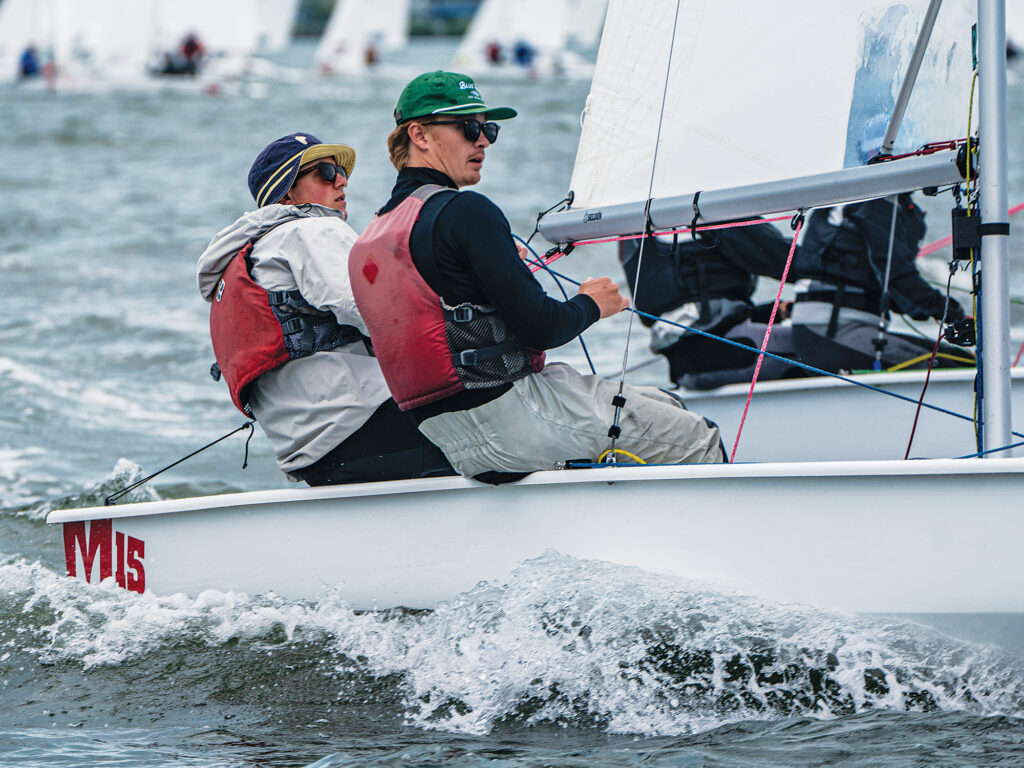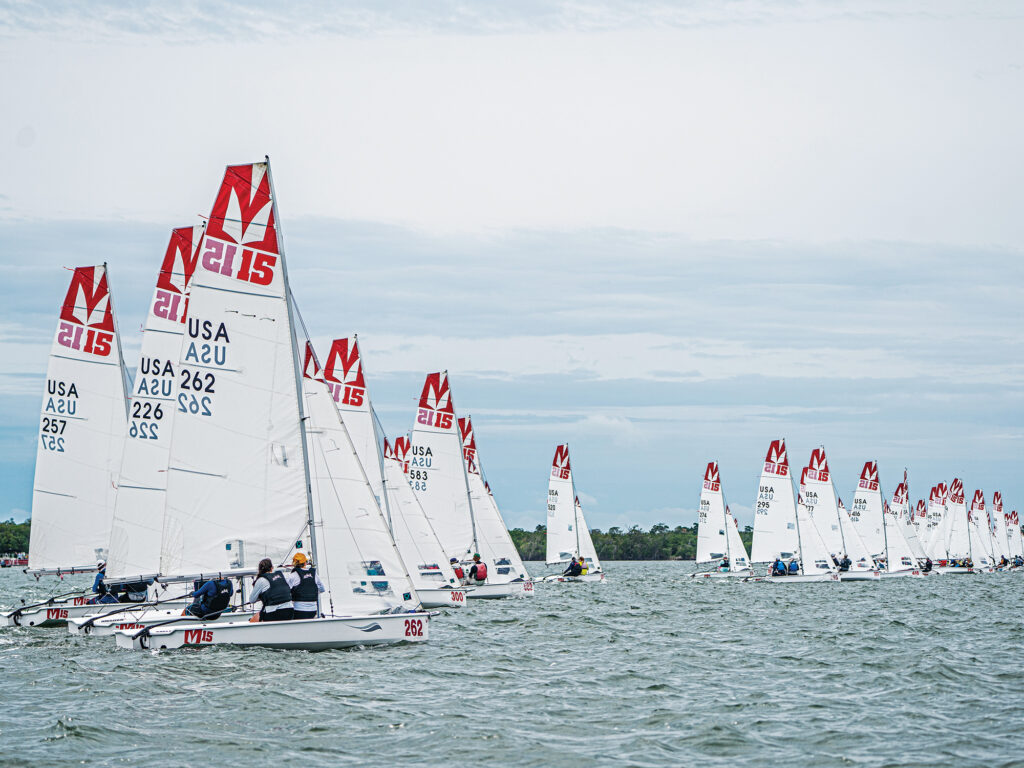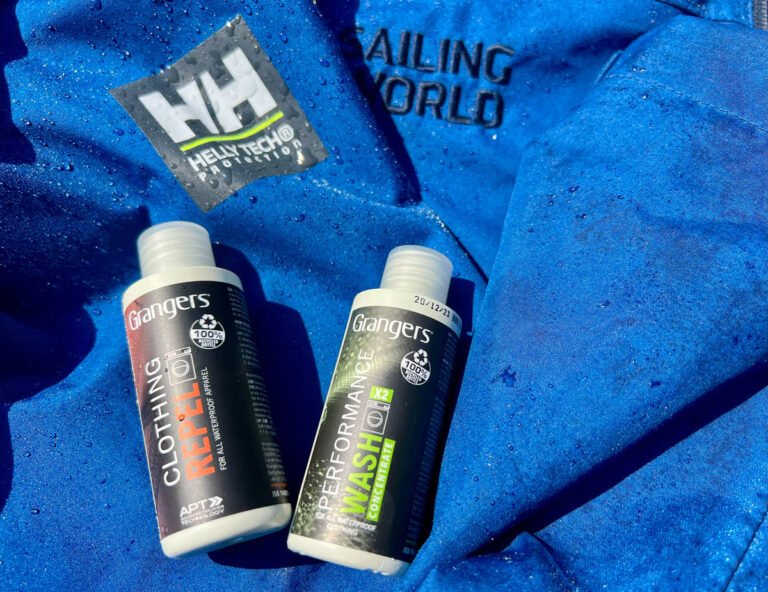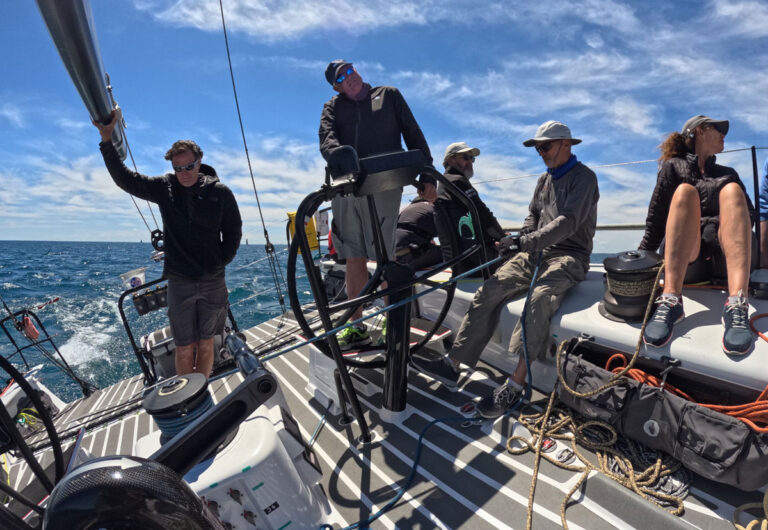
The 65-boat fleet at the 2023 Melges 15 Winter Series was an impressive turnout for a one-design class that’s only three years old. But that was nothing. This year, 90 boats showed up at each of the three series’ events in over three months in Jensen Beach, Florida. The class has subscoring categories for women, youth, master, grand master, mega master, and even a “couples” division, but this year’s winter series was won by a pair of recent college-sailing alumni. The transferable dinghy skills and emphasis on strong sailing fundamentals from college sailing paid off for skipper Luke Arnone and crew Cameron Giblin, from Mantoloking YC, New Jersey. The pair won two of three events, including the final Midwinter Championship, to earn the series title.
What was your strategy for winning the 90-boat Midwinter Championship?
Cameron Giblin: Consistency is really important, especially in the big fleet. You can see people put up some big numbers. We got off to a bit of a slow start ourselves, with a 14 and a 20. The racing was pretty tricky early on, but when we got settled on the second day, rattling off a couple of top-five finishes helped settle the score line. Sometimes you’d rather be chasing than being chased, so it was nice going into the last day with something to fight for.
Three of the races were windy, and four were light; what’s the key to being competitive in either condition?
Giblin: We really like the range because we think we’re a good combined weight and a really dynamic pair, so a lot of people are really consistent in windy or light air, but if we get three different days with three different conditions, we think we have a good combination of smarts and speed in the boat to where we can really capitalize on it.
When you guys are preparing for your races, what is your discussion around strategy?
Luke Arnone: I feel like the game plan is always changing, especially at a venue like Jensen Beach, where we’ve gotten a little more comfortable with the conditions and we started noticing more trends. For example, really digging into the pressure instead of letting it come to you consistently paid off. It’s also a venue where the wind winds a certain direction instead of going back and forth, so digging into pressure and getting that slow shift is what has been paying off for us.
Giblin: Luke and I try to keep everything pretty light in the boat. You know, after some bad races, you can get pretty down, but that’s definitely what causes things to snowball. So we try to reset after races and just hang out, drink water, and not think about racing for a bit. Then, as soon as the Vakaros shows the countdown to a new start [Ed. Note: Vakaros electronics and its companion RaceSense race management software were used by all teams], we start looking upwind, make sure we are all good, and get the water out of the boat. Having a process where we do the same thing again and again produces repeated full results and being consistent. This is super-important over the series of events where there’s a lot of competition and variable conditions. We pretty much try to keep it as simple as possible. We’re a fast boat and we know that, so we try to stay out of the way and get in that front pack early, and then play the game from there.
You were in the top five over the course of the regatta, but you weren’t winning. Did you know you were in contention going into the last race?
Arnone: I never thought we were out of contention at any point in the regatta. We definitely took a good look at the scores [before the final day], and I even had to factor in that the fellas in first place were dropping an 8, meaning only 8 additional points would get added to their score should they have a worse race. That was something good to have in the back of our minds, but we really just wanted to get top threes. That’s all we could do, and that’s what we did.

With 12 to 18 knots for the last two races of the regatta, what was your top speed?
Arnone: We hit 16.5 knots on the final downwind on the layline into the finish when this huge puff took us down angling below the finish line. For a moment we weren’t sure if we were going to make it, coming in at such a hot angle, because if we headed up in that puff, we were going straight over. But we made it around, and that was a blast. I can’t really remember the last time I went as fast in a sailboat.
How did the use of the Vakaros and RaceSense software affect your series?
Giblin: The Vakaros is super-nice, because on the start, we get instant feedback if we’re over or not. So, as the crew, I’d yell, “Green” as soon as I saw from the device that we weren’t over, and then it’d be full speed ahead. We were over in one of the first races on the final day and it blinked “OCS,” but we were able to clear ourselves, and once it tells you that you’ve cleared, it’s super-nice. It was our first time experiencing the OCS technology, and we didn’t have any trouble with it.
I also think it changes your strategy a bit because in big-fleet regattas, when the pack
to windward is over, you can hide your sail number. But with the Vakaros, there’s no hiding. So you really have to know where the line is, and you can’t rely on determining your position based on the boats around you knowing where the line is. You have to trust yourself, because with 90 boats, who knows if other people know where the line is.
What have you observed about the evolution of the Melges 15 fleet and your competitors?
Giblin: The top end of the fleet got a lot bigger. It seemed like at every event that there were a few more people in the top end of the fleet, and anyone could win a race by the end of the regatta. There are 20 teams who could finish the regatta in the top five, and it makes it much more interesting and the points more interesting. It’s cool to see everyone figuring it out week by week, as we are. Everyone is getting better. It’s been great seeing a lot of people from college sailing; many of them are in the different age divisions. A lot of skills from college sailing translate.
Speaking of the parallels of Melges 15s and college sailing, you both recently graduated. Cameron, you graduated from Tulane, and Luke, you graduated from Yale. How does Melges 15 racing compare with college sailing?
Arnone: The Melges 15 is a lot faster than college dinghies, and with the asymmetric spinnaker, the downwind legs are definitely the most fun part about this boat, especially when it’s breezy. With the kite up, we play the angles and sail the lowest path we have while managing waves and our speed.
Giblin: I can see some parallels with the M15 fleet and the college-sailing community. College sailing has a really good community where people respect each other and know we’re going to see each other week in and week out. And that’s kind of being created with the Melges 15 class as well. There are not a lot of protests; there are a lot of class-initiated group debriefs and people asking questions. There really is a sense of the class getting better rather than individuals getting better, which is awesome to see.









